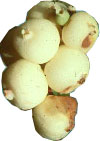Fruit Salad
Home Page

|
Snowberry
|
Mountain snowberry is a low growing, erect and sometimes trailing mountain shrub, with spreading to arching branches. It averages 2 to 4 feet in height, but plants on good sites can grow up to 5 feet. Reproduction is by seed and sometimes by layering. Flowers are white or pink, bell shaped, ¼ to ½ inch long. Found solitary or in pairs. The fruits are small, light green to white berries, up to ½ inch long.
Leaves:
Opposite, and short stalked. Round, elliptical, or thin oval shaped. Top of leaf is usually slightly hairy. Underside of leaves has a gray to whitish hair, and five prominent veins.
Stems:
Young twigs usually lacking hairs, but occasionally densely hairy. Older twigs have reddish-brown shreddy bark. buds are light brown.
Ecological Adaptations:
Snowberry occurs on the edges of riparian zones, in woodlands, and in moist areas of the mountain brush zone, at elevations between 4,800 and 10,500 feet.
Soils:
Occurs in sandy loam to clay loam soils. Does not tolerate much alkalinity or salinity.
Associated Species:
Ponderosa pine, Douglas fir, aspen, chokecherry.
Uses and Management:
Because of its abundance and wide distribution, mountain snowberry is an important source of forage on many mountain ranges. Although not highly nutritious or palatable, mountain snowberry is frequently one of the first species to leaf out, making it a highly sought after food in the early spring. Use by livestock and big game is moderate throughout the summer and declines in fall. Small mammals and birds utilize the fruits. Mountain snowberry's low growth form makes its foliage easily available. Plants withstand browsing well and produce numerous basal sprouts following browsing.
Due to its rhizomatous nature, Mountain snowberry is useful for revegetation of disturbed sites such as road cuts, landscape and recreational plantings, wildlife habitat improvement, and increasing biodiversity on moist sites.
Native Americans used the fruits as an ematic and laxative, and steeped the roots to treat colds and stomachaches.
Symphoricarpos is a small genus of about 15 species of deciduous shrubs in the family Caprifoliaceae. All but one are natives of North America and Central America; the one remaining is from western China. The leaves are 1.5-5 cm long, rounded, entire or with one or two lobes at the base. The flowers are small, greenish-white to pink, in small clusters of 5-15 together in most species, solitary or in pairs in some (e.g. S. microphyllus). The fruit are conspicuous, 1-2 cm in diameter, soft, varying from white (e.g. S. albus) to pink (S. microphyllus) to red (S. orbiculatus) and in one species (S. sinensis), blackish purple.
Common Snowberry (Symphoricarpos albus) is an important winter food source for quail, pheasant and grouse, but is considered poisonous to humans. The berries contain the isoquinoline alkaloid chelidonine, as well as other alkaloids. Ingesting the berries causes mild symptoms of vomiting, dizziness, and slight sedation in children. Common Snowberry is a popular ornamental shrub in gardens, grown for its decorative white fruit. There are two varieties, S. albus var. albus, native to eastern North America, and S. albus var. laevigatus native to the Pacific coast. The latter is a larger shrub, up to 2 m tall, and with slightly larger fruit; it is treated as a distinct species S. rivularis by some botanists.
Physical Characteristics
It is hardy to zone 9. It is in leaf all year, in flower from June to July. The flowers are hermaphrodite (has both male and female organs) and are pollinated by Insects. An evergreen Shrub growing to 1.2m. The plant prefers light (sandy) and medium (loamy) soils. The plant prefers acid and neutral soils and can grow in very acid soil. It can grow in full shade (deep woodland) or semi-shade (light woodland). It requires moist soil.
Edible Uses
Edible Parts: Fruit - raw or cooked. A good flavour. Sweet and juicy but becoming rather tasteless later in the season. The fruit is about 12mm in diameter.
Click here for reference information.
Utah State University (Snowberry)